Chapter 1, Part 3
One morning in Yangon James and I walked from our hotel on 33rd Street to Shwedagon Pagoda, some three kilometers away. The sun was shining brightly, but to the east layers upon layers of clouds rolled on the horizon. I raised my finger to the sky, towards the clouds, to see the direction they were moving: westward, and fast. Based on my memory from my previous visit in 2012, I dashed in front of James and led him to Shwedagon Paya.
More than two millennia ago Ashoka, king of the Maurya Empire, probably moved just as fast, if not faster, in proselytizing the teachings of the Buddha, not only to his subjects but also to lands beyond his realm. His children, Mahinda and Sanghamitta, played a central role in spreading Buddhism to the island of Lanka. The kings of Anuradhapura nurtured the development of the new religion despite frequent attacks by Hindu kingdoms from South India, a region Ashoka never conquered.
Using his immense wealth, Ashoka provided financial support to viharas (Buddhist temples) and sanghas (Buddhist monastic societies). His generosity, however, was both a blessing and a curse as not only did it strengthen Buddhist teaching but also attracted those who wanted to join the sanghas only for the food, clothing, shelter and other facilities. Consequently the Third Buddhist Council was held to purify the monastic societies from those who held wrong views about the religion.
Following the conclusion of the Council, two monks were sent to spread Buddhism to the east, to a land called Suvarnabhumi – land of gold – which is believed to be a part of modern-day Myanmar, although some argue that it is in fact in Thailand, hence the name of Bangkok’s main international airport. Sona and Uttara, the two monks, most likely interacted with the Mon people who at that time ruled the kingdom of Thaton.
However the people in Myanmar believe in the legend that the sixth-century BC kingdom of Okkalapa had already embraced Buddhism not long after Gautama Buddha attained enlightenment. Two Okkalapan merchants by the name of Taphussa and Bhallika visited the Buddha and offered him alms. In return, the Buddha gifted them with eight strands of his hair and instructed them to enshrine the hairs at the place where relics of the three previous Buddhas – Kakusanda Buddha, Kawnagamana Buddha and Kassapa Buddha – were buried.
A pagoda was built after the king of Okkalapa found the exact spot with the help of nats (spirits, widely worshiped in Myanmar). The new shrine was called Shwedagon, ‘Reliquary of the Four’. However historical and archaeological evidence suggests that the pagoda was in fact built by the Mon people around the sixth century AD and further expanded by later kings and queens until it reached its current height in 1774.
More than two thousand years after the spread of Buddhism from its heartland, it is no longer a major religion in India, the historical stronghold of Buddhism. Its influence is only palpable in small pockets in the country, including Sikkim and Ladakh. On the contrary Sri Lanka is today a major Theravada Buddhist stronghold, while more than 80% of the people in Myanmar are Buddhists.
With sweat dripping from all over my face, I was standing before the pagoda, meticulously covered with gold leaves and capped by diamond- and gemstone-laden gilded ornaments. Yangon has changed quite drastically in the three years between my first and second visits; new cars, new malls, KFC, Coca-Cola, and even traffic jams. But Shwedagon remains a quiet refuge from the city’s bustle.
As thick clouds hung over our heads, we slowly walked out of the majestic pagoda compound. Minutes later a heavy downpour washed away the dust and dirt off the gilded monument, the houses, and the trees, slowing down Yangon’s busy pace. Behind us Shwedagon stood tall, a symbol of the nation’s pride and wealth, and of a thriving faith in the land of gold.
Click here for the full list of stories from the Spice Odyssey series.
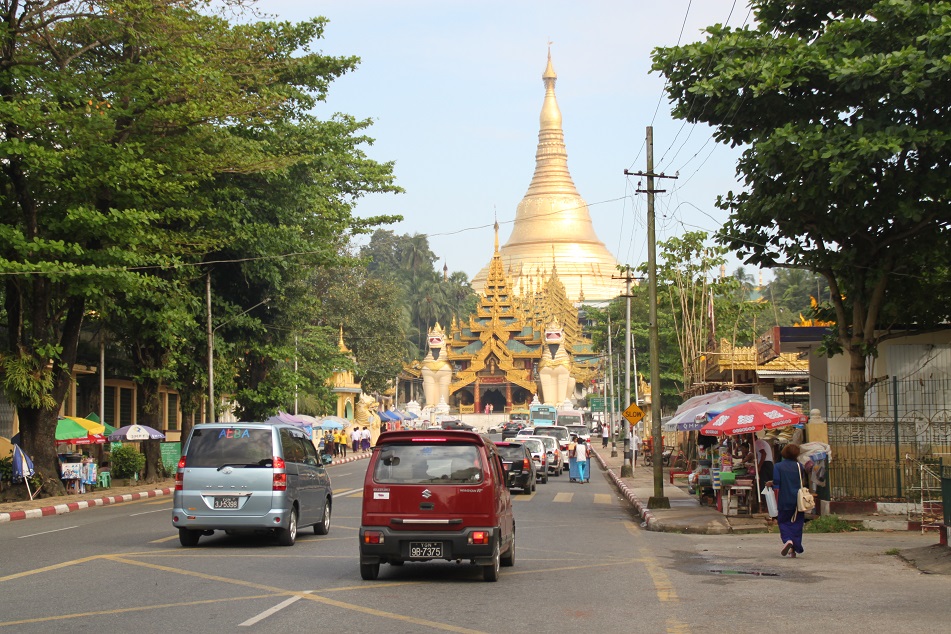
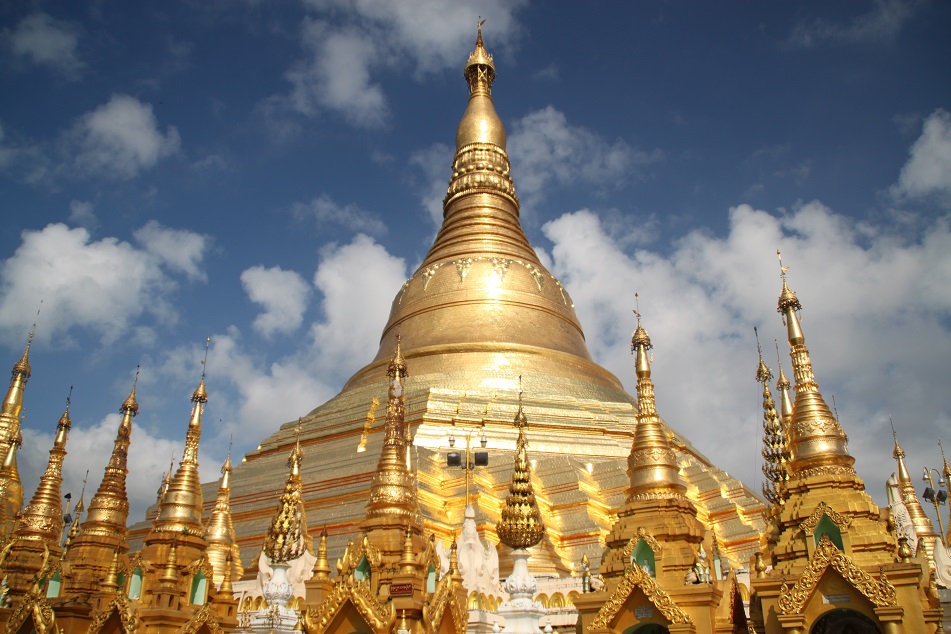
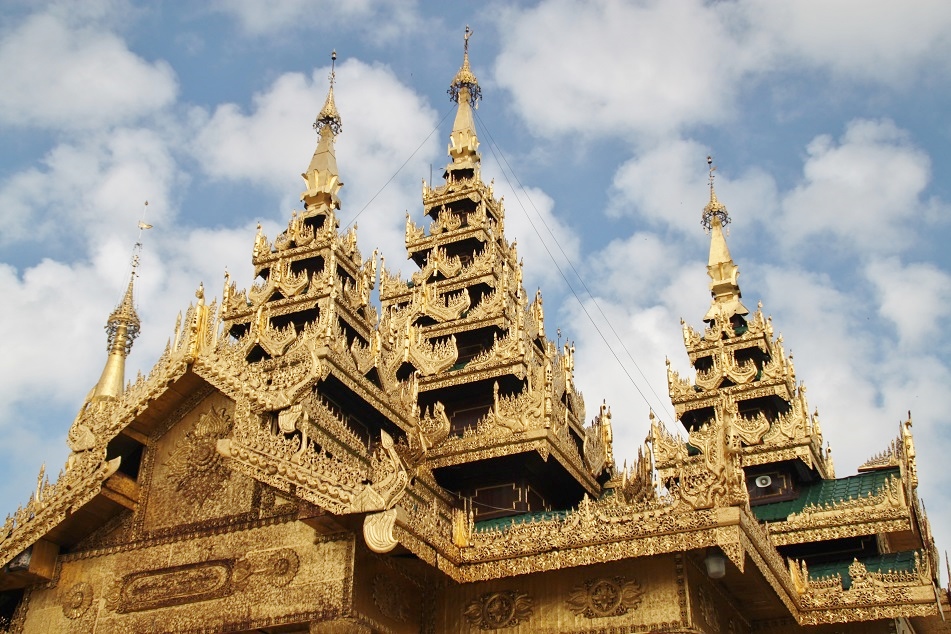
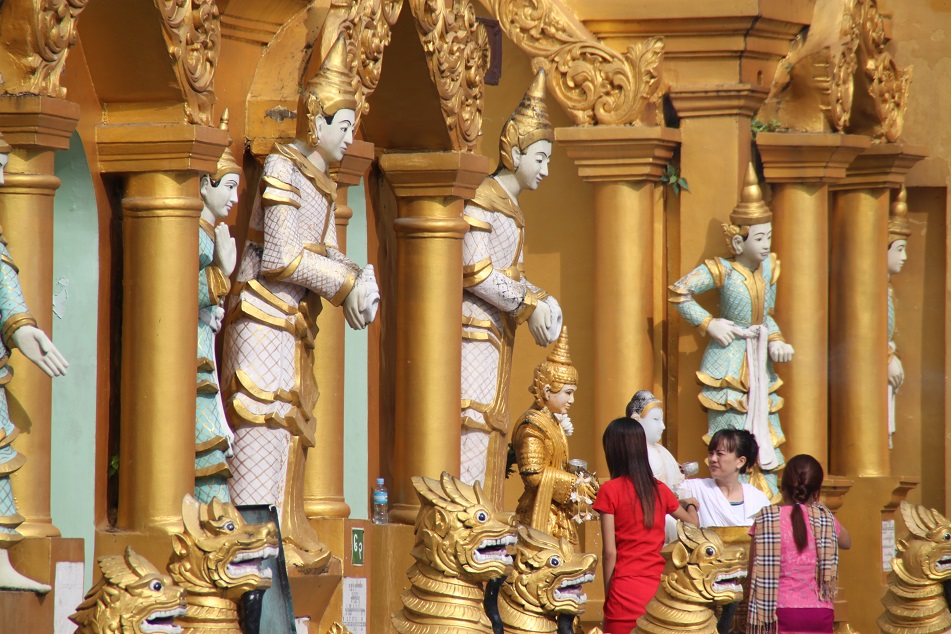


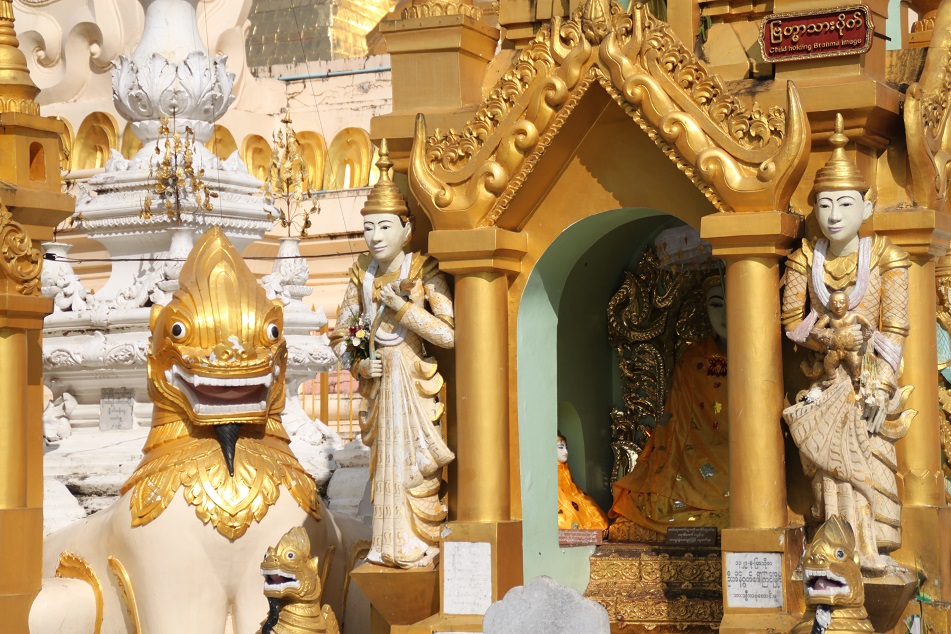
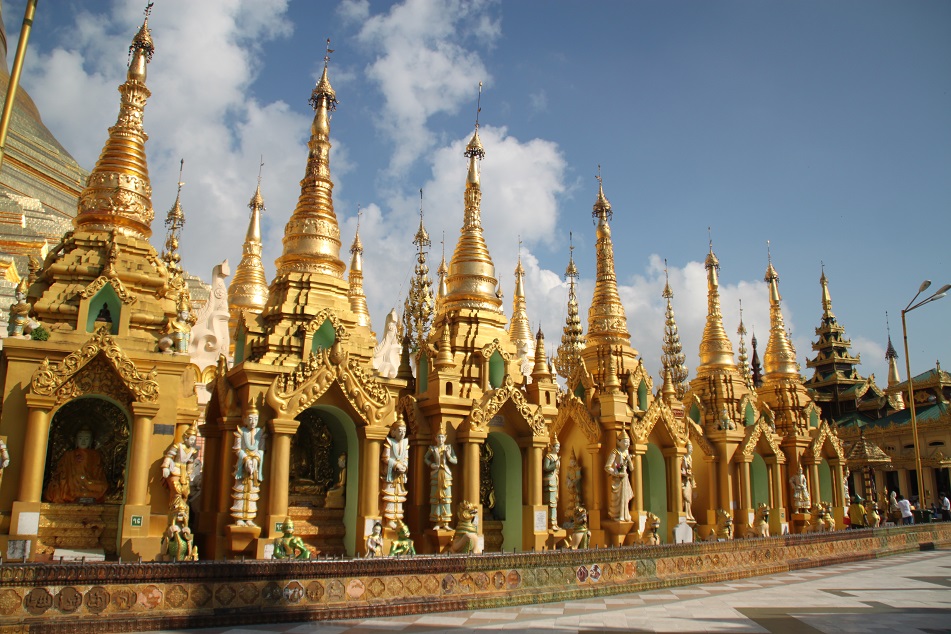
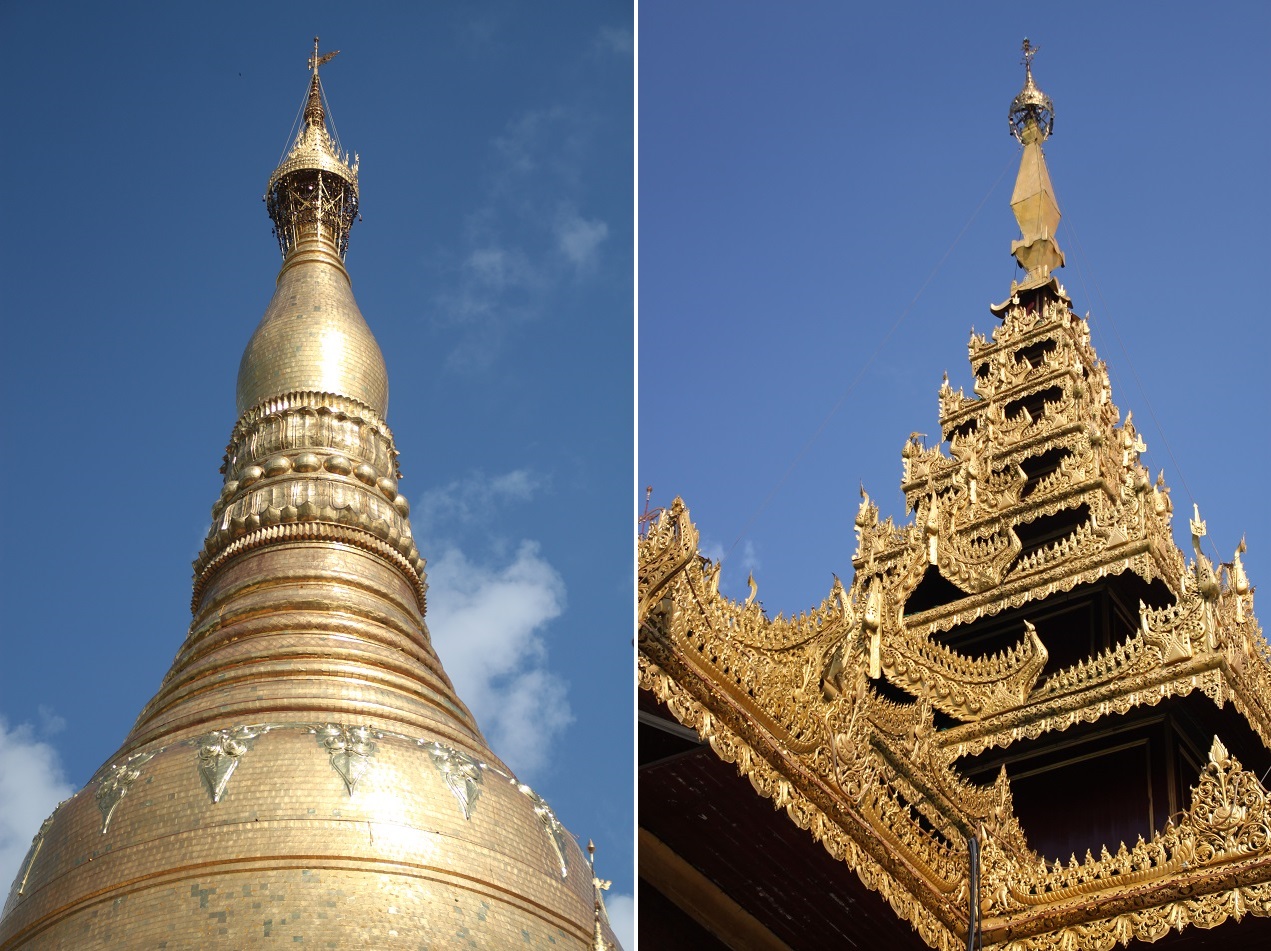

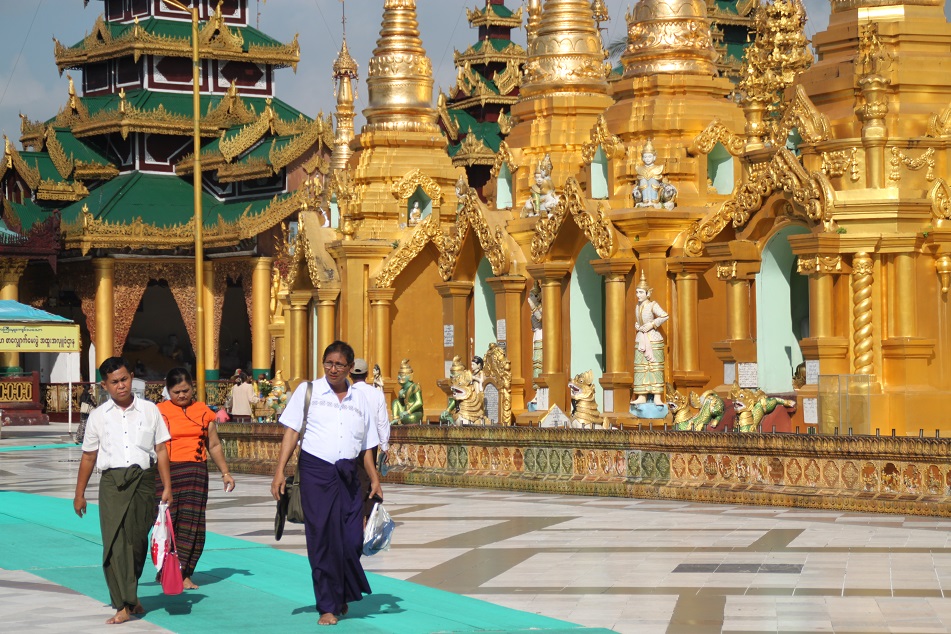
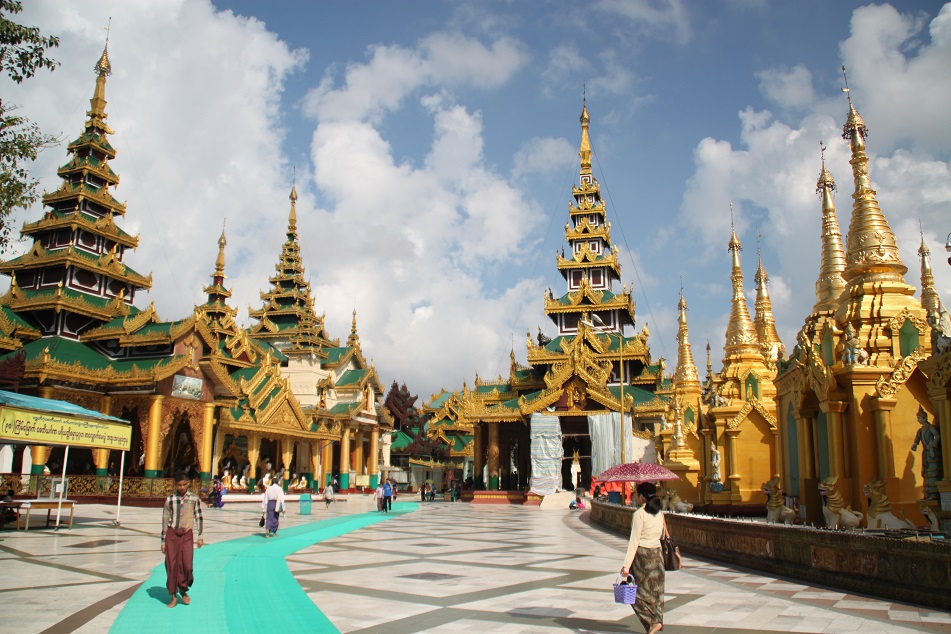
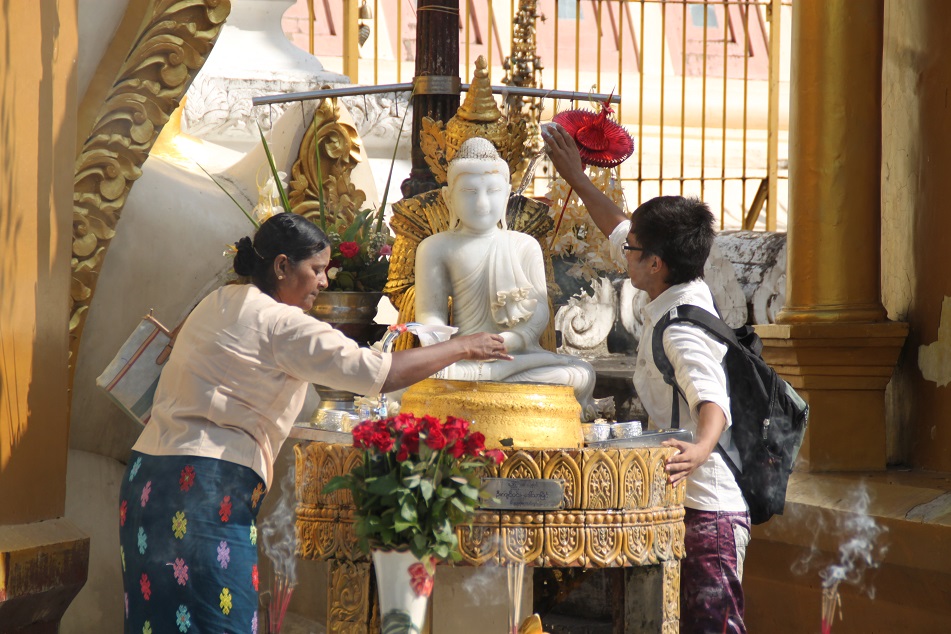

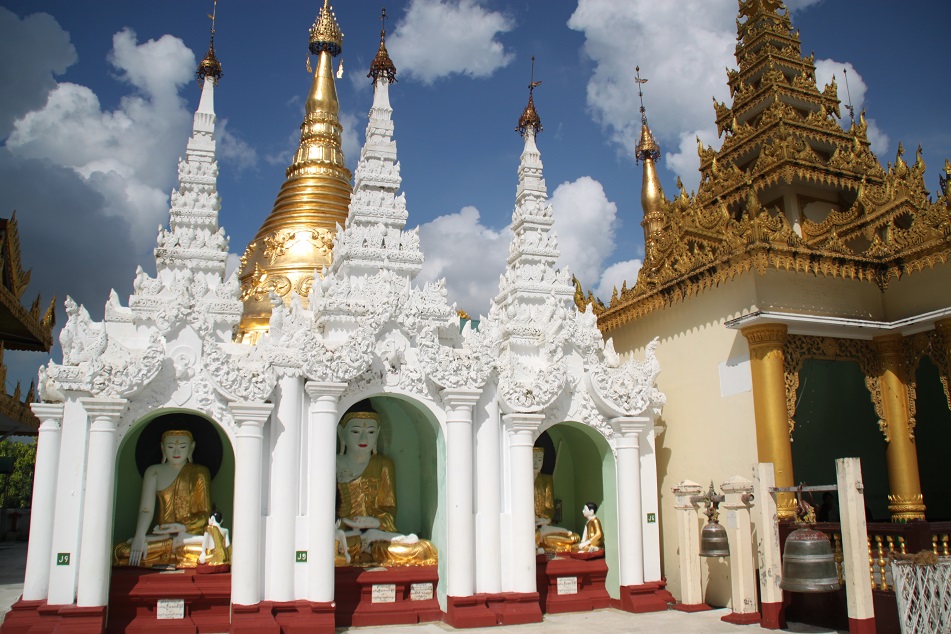
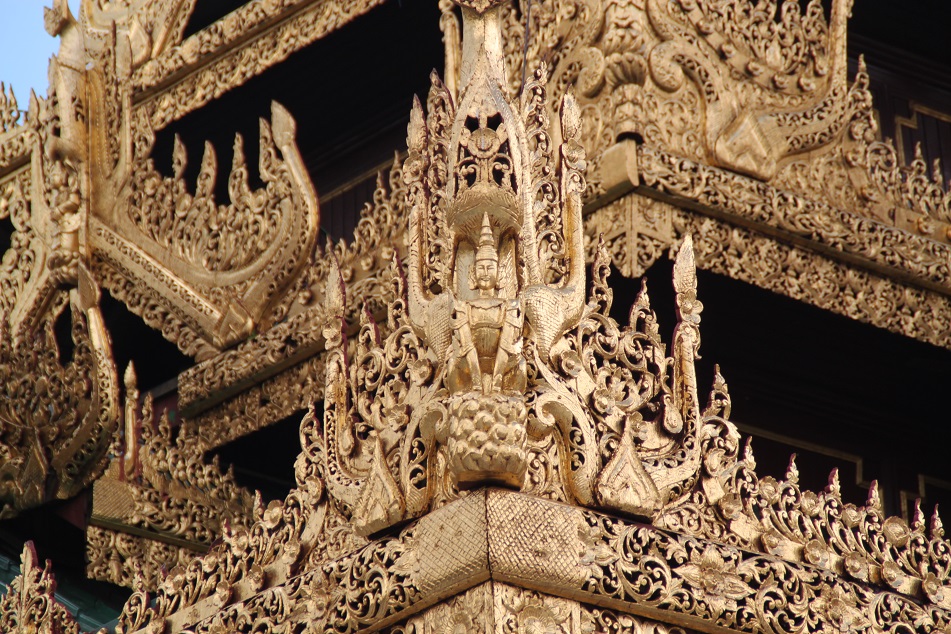
Shwedagon is one of the most awe-inspiring Buddhist temples I’ve ever seen. I have to say it was painful to walk so fast in that suffocating humidity – but you had good reason to get us there quicker. I’m so glad we went early that morning. Half an hour later and we would have been drenched in the torrential rain… our photos would also have turned out very different.
LikeLike
Sorry for half-running all the way to Shwedagon. 😀 But I was really worried by the speed of the clouds moving westward. I’m glad the pagoda didn’t end up being a very touristy place like the Grand Palace in Bangkok where people shouted indifferently. I hope Shwedagon remains that way because it’s a religious site after all.
LikeLiked by 2 people
Impressive creations!
LikeLike
Shwedagon truly is a man-made wonder!
LikeLiked by 1 person
Shwedagon itu memang luar biasa, saya disana dari siang, sore hingga jelang tutup dan menjadi bagian orang-orang terakhir yang turun dari Shwedagon, dari lantai yang panas luar biasa, sampai akhirnya diberi penerangan lampu yang indah banget.
Dan cerita latar Ashoka itu, ah bagusnya…
LikeLike
Wow, pengen sih nyobain ke Shwedagon sore-sore menjelang matahari terbenam. Quite magical I believe. Saya seneng banget pas sampai ke Shwedagon ternyata suasananya tidak banyak berubah dibandingkan dengan kunjungan pertama sekitar empat tahun yang lalu dimana pada saat itu Myanmar baru saja membuka diri. Btw bicara mengenai Ashoka, pernah dengar mengenai Sanchi? Itu salah satu peninggalan kerajaannya yang saya pengen banget kunjungi di India.
LikeLiked by 1 person
Sanchi! itu kan salah satu World Heritage Site yang isinya Stupa yang dibangun Ashoka di abad 2 or 3 BC kan? Waktu kemarin ke India ga sempat ke sana ya? Tetapi India memang perlu berulang kali ya, karena negara itu terlalu luas dan terlalu banyak yang harus dilihat… (itu saya lho, sampai pusing bikin prioritasnya hahaha…)
LikeLike
Betul! Dan yang jadi salah satu kekhasan situs Sanchi adalah torana (gerbang berukir) yang sangat detail dan indah. Sayang kemarin waktu ke India waktunya gak cukup untuk ke Sanchi karena memang fokus saya lebih ke daerah Selatan. Next time! 🙂 Tapi di luar keruwetannya, India memang nagih bagi orang-orang yang suka dengan peninggalan sejarah dan budaya.
LikeLiked by 1 person
Wah hampir dua minggu gak blogwalking aku sepertinya ketinggalan banyak cerita, tau-tau udah part 3 aja Bam.
Cerita dan foto yang menarik Bam, dibalik kuil emas yang kontras dengan kondisi negara Myanmar saat ini. Btw, aku agak bingung dengan penamaan Suvarnabhumi, apakah sama dengan Swarnadwipa yang dahulu dicantumkan untuk Sumatra? Kalau iya, kemungkinan daerah yang disebut sebagai “tanah emas” ini lumayan luas juga cakupannya.
Kalian sempat nyobain pakai longyi gak waktu di Myanmar?
LikeLike
Wah tadinya padahal aku udah mau bikin sampe Part 10 lho. 😀
Makasih Bart. Nah mengenai penamaan Suvarnabhumi ini para ahli sejarah berbeda pendapat. Ada yang membedakan Suvarnabhumi dengan Swarnadwipa (Suvarnadwipa), yang satu di daratan Asia Tenggara dan satunya lagi di pulau terpisah. Tapi ada juga yang berpendapat bahwa Suvarnadwipa ini mencakup Suvarnabhumi juga, dengan kata lain mencakup wilayah luas di sebelah Timur dari India. Untuk cerita ini aku ambil pendapat yang pertama untuk memudahkan dan mengurangi ambivalensi. Mungkin Jawa juga harusnya masuk ke ranah Suvarnabhumi atau Swarnadwipa ya, soalnya banyak “mas” juga. 😀
Gak sempet Bart soalnya pada dasarnya longyi itu sama persis dengan sarung yang kita kenal di Indonesia. Yang aku penasaran pengen coba itu justru mundu di Kerala soalnya itu gak dijahit, jadi basically cuma selembar kain aja. Udah gitu para pria di sana kalau pas lagi kerja atau nyantai biasanya menggulung mundunya sampe di atas dengkul. Pemandangan unik sih.
LikeLiked by 1 person
Wow banyak amat sampai 10. Aku harus buru-buru kejar baca nih, mumpung baru sampai bagian tiga 😀
Noted. Aku juga kayaknya setuju pendapat pertama deh Bam, biar gak bingung, karena lautan yang memisahkannya lumayan signifikan. Dan walaupun di Jawa banyak “mas” juga, mungkin penamaannya beda. Aku pernah baca, kalau penamaan Jawa sendiri berasal dari banyaknya tanaman Jawawut atau Juwawut (Setaria italica-,sejenis sorghum) yang dulu tumbuh subur di situ.
O iya iya, aku sering lihat juga tuh di beberapa film India, dimana sebagian mereka melipat mundu sampai sebatas dengkul. Gak mau kalah sama rok mini kayaknya 😀
LikeLike
Hehe, gak lah. Aku sih paling satu bulan mau posting 4-5 cerita rencananya.
Bart, yang Jawa aku becanda lho. Maksudnya mas-mas. 😀 Iya mengenai penamaan Jawa yang aku pernah baca juga asal mulanya dari nama tanaman Jawawut.
Di tengah panas dan lembabnya udara Kerala, mundu kayaknya memang nyaman banget sih dibanding celana.
LikeLiked by 1 person
Harus rajin dong postingnya, secara itu simpanan dari enam bulan di jalan. Hahahaha iya Bam, soal yang Jawa aku tau itu becandaan juga 😀
Pertanyaanya kenapa mereka gak milih celana pendek aja ya? Tapi bisa jadi mundu praktis juga ya, giliran butuh agak tertutup, tinggal lepas lagi ikatan setengahnya. Btw mundu itu cuma putih atau bercorak juga Bam menurut pengamatanmu?
LikeLike
Iya ini aku maksain rajin nulis mumpung masih agak fresh ingatanku. Untungnya ada catatan juga sih, buat bantu nginget-nginget nanti.
Nah itu. Kalo celana kan harus pilih mau celana panjang atau pendek, kalo mundu cukup satu bisa buat dua-duanya. Lagi kepanasan tinggal gulung, pengen terlihat lebih formal tinggal lepas gulungannya, 2 in 1. Kalo menurut pengamatanku sih sepertinya lebih dari 90% warna mundu itu putih dengan garis di ujungnya dengan warna berbeda.
LikeLike
Di Medan kalau gak salah ada vihara kayak shwedagon ini deh..
LikeLike
Setau saya itu di dekat Berastagi. Wihara/pagoda tersebut memang terinspirasi dari Shwedagon.
LikeLiked by 1 person
Yg bikin shwedagon itu berwarna emas krn emas murni ya bam ?
LikeLike
Iya itu gold leaf, lembaran emas murni yang dibuat dari emas yang dipadatkan.
LikeLiked by 1 person
That pagoda is almost blinding! I always find it interesting to see the different forms Buddhist temples take – from simple painted concrete buildings to these ornate and shiny ones. As we discussed in your last post, how truly unbelievable is it that people thousands of years ago were capable of this grand construction and ornamentation?! I guess I should stop being amazed.
LikeLike
Blinding is a good way to describe how much gold they put on the pagoda. It’s such a magnificent structure so much so people copied it elsewhere in the region, including the one in Myanmar’s new capital (Naypyidaw) and another one in a small town in North Sumatra, Indonesia. I guess we should stop being amazed… although that would be very hard since those ancient structures are just mind-blowing.
LikeLiked by 1 person
Stunning photos! So much gold…
LikeLike
Thank you, Katherine. They really live up to their moniker, Suvarnabhumi, the land of gold.
LikeLiked by 1 person
This may be an impossible question, but where does the pagoda rank in terms of architectural gems you saw on your trip? Those are amazing photos. I didn’t realize how extensive it is.
LikeLike
Jeff, that is a really tough question.
Let me see. Of all the ancient Hindu and Buddhist temples and pagodas I visited on this trip, Shwedagon is near the top of the list. The other contenders are Nyatapola in Bhaktapur (Nepal), Borobudur and Prambanan (Indonesia), Thambula and Htilominlo temples in Bagan (Myanmar), and Brihadeeswarar Temple in Thanjavur (India).
LikeLike
Pingback: Shwedagon: Buddhism in the Land of Gold – Deep-pockets
So incredibly stunning! The temples are magnificent. I would love to go to Myanmar someday. I know now it is a travel hotspot. Was it touristy?
LikeLike
It really is, Nicole. Since the country opened up to the world in late 2011 it has been undergoing a quite dramatic change. Myanmar is still not as touristy as Thailand, but looking at the pace of change the country is undergoing I believe in the next ten years things will look quite different.
LikeLiked by 1 person
That means I must get there soon! Thanks for the comment Bama. A beautiful post!
LikeLike
You must! 🙂 And thank you for your kind words, Nicole. Hopefully you’ll visit Myanmar sooner than later.
LikeLike
this gold color is like an eternal sunshine ! In my mind I was making a a collage of Shwedagon and Borobudur, like to sides of a coin …
LikeLike
It was the reason why I walked really fast to get to Shwedagon, because under the sun the pagoda looked so magical.
That’s an interesting concept, combining Borobudur and Shwedagon, one is made from grey andesite stones, the other is all gilded. Quite dramatic.
LikeLiked by 1 person
Nice post,great photos!
LikeLike
Teşekkür, Senem!
LikeLiked by 1 person
belum pernah tp cakep ya
LikeLike
Pas ke sana pas scaffoldingnya udah dilepas, jadi pagodanya bener-bener mengkilat. Bagus dan indah.
LikeLike
Amazing pictures!
LikeLike
Thank you, Adriana. Glad you enjoyed them.
LikeLike
Check you mine? https://adrianapanova.wordpress.com/
LikeLike
Love the article. I’ve lived in Yangon for a couple of years and Shwedagon was one of my favourite places to visit in the evenings.
The architecture’s absolutely stunning. Your post brought back old memories.
LikeLike
Thank you! Most people who come to Myanmar fall in love with its countryside, as well as Bagan and other majestic temples. Sure they are all amazing. However I found Yangon charming, in both of my visits to the city. I’m glad this post brought back some fond memories to you.
LikeLike
Your journey is so amazing, thank you for sharing this!
LikeLike
And thank you for reading! 🙂
LikeLike
What a great view of the Shwedagon Pagoda also known as the Great Dagon Pagoda or the Golden Pagoda. I remembered when I went to Phuket Thailand last June of 2012 I also wore a Htamein given to all the lady tourist as a dress code to respect the sacred temples there.
LikeLike
Wearing a traditional dress at places considered sacred by the locals is indeed a nice thing to do. I do hope the people in Myanmar will still wear longyi and htamein along with pants and jeans, because one of the things that makes a place truly unique is its traditional costume.
LikeLike
Sumptuous photos and narrative Bama. We kept the Shwedagon for the last and spent all evening there from sunset until twilight. The faith and the fervour was magical to witness. Sadly, the entire folder of raw images from that evening, save for the few I processed for a post, got accidentally deleted while backing up! Feel like an absolute idiot 😦
LikeLike
I always went to Shwedagon in the morning, I wonder if I should do an afternoon visit should I happen to be in Yangon again. Oh no! Photos are really our treasures, aren’t they? Actually James also experienced the same thing on the trip — he accidentally deleted some photos he took. I myself lost all of my photos from my past travels prior to 2013 because I dropped my external harddrive! Oh well, at least you didn’t lose all.
LikeLike
Spectacular photos! Beautifully written with terrific information.
LikeLike
Thank you for your kind words! Much appreciated.
LikeLiked by 1 person
Pingback: Bagan Rising | What an Amazing World!
Such an interesting read!
LikeLike
Glad you enjoyed this post, Vy.
LikeLiked by 1 person
Pingback: Yangon, Three Years Later | What an Amazing World!